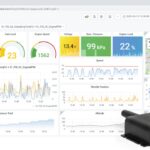Navigating the intricacies of pre-OBDII diagnostic systems, like those found in the Lamborghini Diablo, requires a deep understanding of their unique architecture. Unlike modern vehicles equipped with standardized OBD2 protocols, earlier models utilize manufacturer-specific diagnostic procedures. For enthusiasts and mechanics working on these classic supercars, pinpointing electrical faults demands meticulous testing and a familiarity with legacy systems.
One common diagnostic challenge arises from shield connection issues within the wiring harness. A recent query from a Diablo owner highlights this perfectly, focusing on problems identified through Wire Service Manual (WSM) procedures. The owner reported failing two key tests: an open circuit in the “Engine speed and TDC and Phase sensors shield connection” and the “Lambda probe shield,” both of which should measure approximately 0.2 ohms.
According to the wiring diagrams for the Diablo, the engine speed sensor, TDC sensor, phase sensor, and lambda probe share a common shield connection within the wiring harness. Despite the failed shield connection tests, resistance checks of the phase sensor and engine speed/TDC sensor were within acceptable ranges. Furthermore, the crude on-board diagnostic system, indicated by blinking dash lights, was not displaying any codes related to the lambda probe or engine speed/phase sensors. Interestingly, fault codes were present for battery voltage and the coolant temperature sensor, even after replacing the latter.
This situation began with a rich running condition when the engine warmed up, initially suspected to be a faulty water temperature sensor. While replacing the sensor temporarily cleared the codes, they reappeared under hard acceleration. Subsequent diagnostic testing then revealed the shield connection errors.
This raises several critical questions. Could faulty lambda sensor(s) be the root cause, despite not triggering specific lambda-related fault codes in the rudimentary onboard system? Or is the issue a more fundamental wiring problem affecting the continuity of the shield connection shared by these critical engine management components? A break or corrosion within the harness itself could easily explain the open circuit readings.
Troubleshooting this requires a systematic approach. Firstly, a thorough physical inspection of the wiring harness is essential, paying close attention to areas prone to chafing, damage, or corrosion. Specifically, examining the common shield connection point within the harness is crucial. Secondly, even though the sensors passed resistance tests, their overall functionality cannot be ruled out. Lambda sensors, in particular, can degrade over time and provide inaccurate readings without necessarily triggering a definitive fault code, especially in pre-OBDII systems with less sophisticated monitoring capabilities.
Therefore, further investigation should include:
- Detailed wiring harness inspection: Look for any visual signs of damage, especially to the shielding.
- Continuity testing of the shield wire: Trace the shield wire throughout the harness to identify any breaks.
- Lambda sensor testing: While not triggering codes, consider testing or even temporarily replacing the lambda sensors to rule them out as the cause of the rich running condition and potential contributors to the shield issue.
- Review of battery voltage and coolant temperature sensor circuits: Although new, re-examine these circuits for wiring issues or connector problems that might be falsely triggering codes.
While the diagnostic capabilities of pre-OBDII systems like the Diablo are limited compared to modern OBD2 standards, methodical troubleshooting and a solid understanding of the vehicle’s electrical system are key to resolving these complex issues. For owners and technicians unfamiliar with these older systems, consulting detailed wiring diagrams and service manuals is indispensable for accurate diagnosis and repair.
